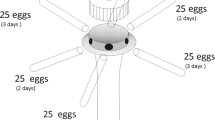Abstract
Wild-caught specimens of the lacertid lizard Gallotia galloti eisentrauti from the Canary Island of Tenerife were checked for ectoparasites. The parasitic gamasid mite Ophionyssus galloticolus Fain and Bannert (2000) was very abundant on these lizards. Additionally, parasitism by larvae of two species of Trombiculidae (Prostigmata: Parasitengona) was observed. O. galloticolus was reared in the laboratory on its natural host in order to investigate its life cycle, reproductive biology, and development. The life history of O. galloticolus is documented in detail and compared to literature data of other Ophionyssus species. O. galloticolus was found to be similar to other species of the same genus with respect to the duration of development, the precopulatory association of protonymphs, and the arrhenotokous development of eggs. However, it seems to be more tolerant towards low relative humidity and longer starvation periods than other Ophionyssus species. Evolutionary transformations of the life-history pattern of this genus and other parasitic mites in comparison to its predatory precursors involve a reduction or partial suppression of ontogenetic instars in order to decrease mortality during host-seeking phases, and a compensating increase in growth capacity of the remaining feeding instars facilitated by replacement of sclerites through elastic cuticle or by growth of new cuticle unrelated to a moult (neosomy).
Similar content being viewed by others
References
Alberti, G., Storch, V. and Renner, H. 1981. Ñber den feinstrukturellen Aufbau der Milbencuticula (Acari, Arachnida). Zoologische Jahrbücher für Anatomie 105: 183–236.
Alvarez Calvo, J.A. 1978. Ciclo biologico de Karyolysus octocromosomi (Sporozoa, Apicomplexa: Haemogregarinidae) en el reptil Lacerta hispanica Steindachner 1870 y en el acaro Ophionyssus saurarum Oud. 1901. Revista de Parasitologia 34: 27–34.
André, H.M. 1992. Calyptostases as indicators of developmental constraints in mites and other arthropods. Acarologia 33: 223–231.
Audy, J.R., Radovsky, F.J. and Vercammen-Grandjean, P.H. 1972. Neosomy: radical intrastadial metamorphosis associated with arthropod symbiosis. J. Med. Entomol. 9: 487–494.
Bannert, B. 1998. Zur Fortpflanzungsbiologie der Halsbandeidechsen von Madeira und den Kanarischen Inseln in Gefangenschaft. Salamandra, Rheinbach, 34 (4): 289–300.
Bannert, B, Lux, E. and Sedlaczek, J. 1995. Studies on endo-and ectoparasites of Canarian lizards. In: Llorente, G. A. et al. (eds), Scientia Herpetologica, Barcelona pp. 293–296.
Camin, J.H. 1948. Mite transmission of a hemorrhagic septicemia in snakes. J. Parasitology 34: 345–354.
Camin, J.H. 1953. Observations on the life history and sensory behavior of the snake mite, Ophionyssus natricis (Gervais) (Acarina: Macronyssidae). Chicago Academy of Sciences, Special Publication 10: 1–75.
Domrow, R. 1985. Species of Ophionyssus Mégnin from Australian lizards and snakes (Acari: Dermanyssidae). J. Austral. Entomol. Soc. 24: 149–153.
Domrow, R., Heath, A.C. and Kennedy, C. 1980. Two new species of Ophionyssus (Acari: Dermanyssidae) from New Zealand lizards. New Zealand J. Zool. 7: 291–297.
Evans, G.O. and Till, W.M. 1966. Studies on the British Dermanyssidae (Acari: Mesostigmata)-Part II Classification. Bulletin of the British Museum (Natural History) Zoology 14: 109–370.
Fain, A. and Bannert, B. 2000. Two new species of Ophionyssus Mégnin (Acari: Macronyssidae) parasitic on lizards of the genus Gallotia Boulenger (Reptilia: Lacaertidae) from the Canary Islands. Internat. J. Acarol. 26(1): 41–50.
Fonseca da, F. 1954. Notas de Acarologia XXXVI Aquisiçoes novas para a fauna brasileira de Acaros hematophagos (Acari, Macronyssidae). Revista Brasileira de Entomologica 1: 79–92.
Frye, F.L. 1991. Biomedical and surgical aspects of captive Reptile husbandry. Vol. I. Captive reptiles, Diseases, 2nd edn, Florida (Krieger Publishing Company) pp. 281–326.
Lees, A.D. 1952. The role of cuticle growth in the feeding process of ticks. Proc. Zool. Soc. London 121: 759–772.
Micherdzinski, W. 1980. Eine taxonomische Analyse der Familie Macronyssidae Oudemans, 1936. I. Subfamilie Ornithonyssinae Lange (Acarina: Mesostigmata). Polska Akademia Nauk, Warzawa, 263 pp.
Micherdzinski, W. and Lukoschus, F.S. 1987. Eine neue Ophionyssus Art von Java (Acarina: Mesostigmata: Macronyssidae). Zoologische Meddelingen 61: 421–429.
Oliver, J.H. jr., Camin, J.H. and Jackson, R.C. 1963. Sex determination in the snake mite Ophionyssus natricis (Gervais) (Acarina: Dermanyssidae). Acarologia 5: 180–184.
Radovsky, F.J. 1994. The evolution of parasitism and the distribution of some dermanyssoid mites (Mesostigmata) on vertebrate hosts. In: Mites; Ecological and evolutionary analysis of life-history patterns, M.A. Houck (ed.) pp. 186–217. Chapman & Hall, New York.
Reichenow, E. 1913. Karyolysus lacertae, ein wirtswechselndes Coccidium an der Eidechse Lacerta muralis und der Milbe Liponyssus saurarum. Arbeiten aus dem Kaiserlichen Gesundheitsamte 45: 317–363.
Reichenow, E. 1919. Der Entwicklungsgang der Hämococcidien Karyolysus und Schellackia nov. gen. Sitzungsberichte der Gesellschaft Naturforschender Freunde, Berlin, pp. 440–447.
Reichennow, E. 1921. Die Haemococcidien der Eidechsen, Vorbemerkungen und 1. Teil: Die Entwicklungsgeschichte von Karyolysus. Archiv für Protistenkunde 42: 179–291.
Svahn, K. 1975. Blood parasites of the genus Karyolysus (Coccidia, Adeleidae) in Scandinavian lizards. Description and life cycle. Norwegian J. Zool. 23: 277–295.
Winston, P.W. and Bates, D.H. 1960. Saturated solutions for the control of humidity in biological research. Ecology 41: 232–237.
Wohltmann, A. 1999. Life History Evolution in Parasitengonae (Acari: Prostigmata): Constraints on number and size of offspring. In: Evolution and Ecology of the Acari, J. Bruin, L.P.S. van der Geest and M.W. Sabelis (eds). pp. 137–148, Kluwer Academic Publishers, Dordrecht, The Netherlands.
Author information
Authors and Affiliations
Rights and permissions
About this article
Cite this article
Bannert, B., Karaca, H. & Wohltmann, A. Life cycle and parasitic interaction of the lizard-parasitizing mite Ophionyssus galloticolus (Acari: Gamasida: Macronyssidae), with remarks about the evolutionary consequences of parasitism in mites. Exp Appl Acarol 24, 597–613 (2000). https://doi.org/10.1023/A:1026504627926
Issue Date:
DOI: https://doi.org/10.1023/A:1026504627926




